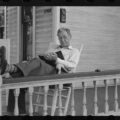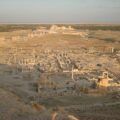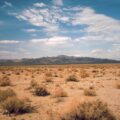Writing Out of Time: J.M.G. Le Clézio

Desert
by J.M.G. Le Clézio
Hardcover, $25.95
David R. Godine, 2009
J.M.G. Le Clézio is an adherent of extreme environments. The author spent about one-third of his Nobel speech fondly recounting his travels through the Darién Gap, the mostly lawless and uninhabited 200-kilometer swath of jungle that is so-called because it is the only place in all the Americas too untamable to allow the construction of the Pan-American Highway. Although the Gap wasn’t crawling with paramilitary forces, terrorists, and drug runners when Le Clézio traveled through it thirty years ago, it still wasn’t the friendliest place to be; but by his own reporting Le Clézio loved the wilderness and became enraptured by the Amerindian approach to oral storytelling.
Desert, the second of Le Clézio’s novels to be published Stateside since he received the Nobel, is the story of an environment that is the very opposite of the Darién Gap’s incredible fertility, yet also shares many correspondences with it. The desert, like the Darién, is a land inhabited by nomadic indigenous peoples, a place defined far more by its harsh environment than anything that human hands have done to change it. As Le Clézio describes it in his novel, it is a place of natural order, one not crowded by people, a landscape free from the suffocating modern order that reigns in more civilized quarters. It is a place of no productive value, and thus one that indigenous people were able to escape to when colonial forces impinged on the more economically valuable regions of their homeland. But make no mistake: no productive value is far from meaning no value at all. Just as Le Clézio’s speech makes it clear that he loved the jungle for what it was, the French Nobelist’s novel makes clear his special affinity for this dry, harsh place.
Desert was acclaimed as Le Clézio’s “breakout” novel by the Swedish Academy, but the book’s mass appeal can be difficult to see at first — it is not the easiest read to get into. It starts with a gathering of thousands of Moroccans around the famous sheik Ma el Aïnine, a man who led an anti-colonial jihad in the first quarter of the 20th century and succeeded in deposing the Sultan before being turned back by the French military. Although we are introduced to certain characters in this opening scene, Le Clézio’s vantage is so wide that we never attain any degree of intimacy with anyone, and it is clear that what most interests Le Clézio is painting a portrait of this incredible accumulation of human beings and the environment in which they wait. Notably, in this opening section Le Clézio never once directly mentions the broader historical forces in which these people are caught up, or even the reason for which they will march. Though Desert is informed by those turn-of-the-century maladies, colonialism and warfare, it is not about either of these topics in the least. Le Clézio only cares for the lived experience of people caught up in these forces, and he does not dilute their lives with recourse to philosophical or historical abstraction. His panorama is powerful for its sense of humanity amassing in religious conviction from out of the wide and empty desert, but those looking to fiction for vivid characters and a strong sense of plot might be put off by these first fifty pages.
Those, however, who are intrigued by the titular landscape will find much to enjoy. This opening section establishes Le Clézio’s great familiarity with the Moroccan desert. It is redolent with place-names and historical information casually strewn across the pages. Although factual matters, like the great invocation delivered by the sheik to end this section, could have been researched by anyone anywhere, other moments prove Le Clézio as one who has lived in this landscape:
Perhaps it was the silence that had come from the desert, from the sea of dunes, from the rock-filled mountains in the moonlight, or from the great plains of pink sand where the sunlight dances and wavers like a curtain of rain; the silence of the green waterholes, looking up at the sky like eyes, the silence of the cloudless, birdless sky where the wind runs free.
As the sermon closes and the followers of Ma el Aïnine begin their march north, we jump forward to just after World War II to a Moroccan shantytown on the outskirts of an unnamed city just off the banks of the Mediterranean sea. A young girl named Lalla, one of the inhabitants of this shantytown, is introduced and becomes the novel’s principal character. Although Le Clézio is careful to characterize Lalla in rich and imaginative detail, there is still an implicit distancing from her for the entirety of the novel, a distancing so consistent and so carefully observed that Le Clézio must have meant it. This distancing serves two ends. In the first, it enhances Lalla’s otherness and fundamental exoticism, aspects of her character that Le Clézio will draw on when she immigrates to France. In the second, this distancing elevates the desert above the people; by keeping us distant from Lalla, Le Clézio can better draw us close to the desert she lives in.
All that is to say that Desert is not a page-turner, a fact most evident in the Lalla sections. As befits a book attempting to articulate a non-Western sensibility, Desert moves to a rhythm of its own, and those not willing to embrace the book on its own terms will likely find it dull. But those readers who are able to open their mind will find a rich portrayal of a distant way of life and a writer who is working quite hard to find a language with which to convey it.
It is worth reading Desert to see the strange quality of Le Clézio’s prose in the Lalla sections. It is writing out of time. Yes, Lalla has a past, but she never develops a future. In Lalla’s idyllic childhood there are no aspirations or plots to draw us forward. Each sentence is quietly set in place like a twig added to a birdnest. In no small part this timeless approach lets Le Clézio describe Lalla without holding her up as an object of study, an essential matter for a Frenchman writing about pre-colonial Morocco.
Obviously, as a Westerner and a citizen of the colonizing nation, Le Clézio is in an odd position with respect to his subject matter, and this is where his obvious intimacy with Moroccan desert life and his literary acuity allow him to succeed. He is able to write about Lalla’s life and society without sounding like a tourist, and this is largely due to the carefully tailored approach he uses. Le Clézio adopts some odd grammatical tics to distance us from Lalla, using his prose to estrange her from the flow of quantified time and strip her of any meaningful action. Although many events take place in the Lalla sections, we rarely feel that Lalla herself does anything. It all just happens, and thus we feel as estranged from Lalla as we do from the desert sands continually blown about by the wind. Take for instance this representative passage from Le Clézio’s narration of Lalla,
Lalla really likes the paths around the dunes. She remembers the first few days after arriving in the Project, after her mother had died with the fevers. She remembers her journey in the tarp-covered truck, and her father’s sister, the one named Aamma, being wrapped up in the large, gray woolen cloak, with her face covered because of the desert dust.
Notice how Lalla never actually does anything in this passage: she “likes” and she “remembers,” but these are weak stative verbs, not strong action ones; elsewhere, Lalla “is,” she “feels,” she “loves,” occasionally she “asks,” but there are precious few verbs with which Lalla pursues tangible activities. Even when a man tries to force himself on her in a cave, Lalla’s screams are indirect: “The damp shadows are closed tightly around her, veiling her eyes, the weight of the shepherd’s body is preventing her from breathing. Finally, she’s able to wrench out a scream, and her voice echoes like thunder off the walls of the cave.” Lalla doesn’t simply scream, she doesn’t even wrench out a scream; no, Lalla merely is able to wrench out a scream.
Despite not endowing Lalla with strong action, Le Clézio is nothing if not a careful observer of his protagonist. Thus we come to know about Lalla’s dead mother, we learn about the many ways in which Lalla consummates her love of the dunes and the beach, we share her occasional mystical experiences in the desert’s depths, we even get a deftly nuanced portrait of her ambiguous relationship with mute a sheep-herder called “the Hartani.” But for all that character detail we rarely feel close to Lalla.
However, Le Clézio does know how to evoke emotion when he wants do, making us feel the majesty´ of the desert and the beauty of the many forms that its light — and light’s opposite, shadow — can take. Le Clézio is not one to rhapsodize his terrain with extended imagery or to join together strings of flashy words; his vocabulary in Desert is condensed, his language almost naïve in its simplicity, and his sentences tend to be short and declarative. C. Dickson’s translation does an exemplary job of staying within Le Clézio’s narrow register, avoiding repetition but never giving us a sentence that sounds out of character. Often the stripped-down prose works to powerful, practical effect, as when Le Clézio writes “All day long, Lalla listens to the calls of the shepherds in the hills, whistling that bores through the white silence”; although occasionally one wishes that he reached a bit farther for a figurative remark: “There’s something like the taste of blood about this day, because it’s the day they have to kill the sheep.”
Throughout the desert sections Le Clézio repeatedly traces back to a nomad song. It comes to embody many different things, but perhaps none better than simply the desert’s harsh, elegiac feel,
One day, oh, one day, the crow will turn white, the sea will go dry, we will find honey in the desert flower, we will make bedding of acacia sprays, oh, one day, the snake will spit no more poison, and rifle bullets will bring no more death, for that will be the day I will leave my love . . .
The song’s hopeful beginnings and the neat and final reversal made in its ultimate clause embody the fallen but nonetheless beloved desert world in which Lalla and her family pass their lives. Their world is what it is: yes, the crows are black, the snakes bring death, but to have it any other way would mean death, a permanent separation from those things in life that one loves despite the deprivations. This is Lalla’s childhood and her desert: a place of danger and death but also a home of much beauty and splendor, a place no one would rightly leave unless forced to.
This is perhaps where Desert is at its weakest. I have no doubt that Lalla is best-suited to her shantytown where she can enjoy isolated walks through the endless sands — and, indeed, Le Clézio does a masterful job communicating Lalla’s love for her home — but Le Clézio might have given slightly more indication that for many of Lalla’s fellow dwellers even a poor immigrant’s life is preferable to rural poverty. At one point he makes the doubtful claim that “the odd thing here in the Project is that everyone is very poor, but no one ever complains.” Maybe, but probably not.
As one progresses through Desert, the book’s carefully conceived structure and its system of dialectics become more and more clear. Lalla’s section closes with her setting off on a journey through the desert with the Hartani to escape inevitable marriage to a wealthy older man, and Le Clézio suddenly jumps back over to the sheik, leading a monumental march of rivers of Moroccans through the desert toward the city of Taroudant, where he will make his bid to beat back the colonial powers. Lalla’s puny and failed march (she succumbs to exhaustion and is inexplicably left behind by the odd Hartani) is contrasted by Ma el Aïnine’s epic and triumphant one; likewise, the sheik’s eventual defeat at the hands of French corresponds to Lalla’s immigration to Marseilles after she is found abandoned for dead in the desert.
Lalla’s immigration across the sea to settle with her surrogate mother Aamma in a dingy quarter of Marseilles begins the action in the third section of the book, entitled “Life with the Slaves.” By contrast, the section proceeding — in which we see Lalla’s life in the desert and the sheik’s march — is titled “Happiness.” This is about as heavy-handed as Le Clézio gets as he quietly sets up the port city as the opposite of the desert: Marseilles is always “damp,” its artificial light is “harsh,” it is a crowded place of endless people; opposing this is the desert, which has its celebrated sun, is dry (and water there is always refreshing), and, of course, is characterized by great expanses of emptiness. Lalla’s homelust is obvious, and it is clear she would prefer Morocco even were she not impoverished and looked down upon. The only parts of Marseilles she likes at all are those that recall parts of the desert, and she continually tries to regain the desert’s sensation of space by hiding herself within the folds of a great brown coat so that the city inhabitants will cease to notice her, and thus will not interact with her. This is a means of survival for Lalla, who is clearly overwhelmed by the city’s bustle and by the many men who greedily eye her developing body.
By only showing us Marseilles from a poor immigrant’s perspective, Le Clézio ensures that the desert appears much more hospitable than the alienating city, although it must be said that the author does not shrink from letting us see the desert’s harsh realities either. IfDesert is a book that implicitly sympathizes with that landscape and the people who are its inhabitants, that is because this is Le Clézio’s method for becoming intimate with his book’s true subject. That is to say that though Desert celebrates this arid land it doesn’t run afoul of sentimentality; the desert is portrayed as superior to Marseilles because Lalla finds it so, but she is also well aware that the desert can be an unforgiving place.
In a brief coda after Lalla escapes Marseilles and Ma el Aïnine sees his hopes crushed, Le Clézio lets us know that though Morocco never had a chance to escape colonialism’s forced modernity, there are parts of it that can never be Westernized, if only because the logic of Western civilization cannot make any sense of them. This is felt in Lalla’s great relief at being back in the desert, as well as in the collective consciousness of Ma el Aïnine’s retreating men,
They had nothing but what their eyes saw, what their bare feet touched. Before them, the flat earth stretched out like the sea, glistening with salt. . . .
There was no end to freedom, it was as vast as the wide world, beautiful and cruel as the light, gentle as the eyes of water Each day, at the first light of dawn, the free men went back toward their home, toward the south, toward the place where no one else could live.
It is a fitting conclusion to a tragedy that is essentially already told, and it drives home the fact that Desert is a dramatization of certain things that Western civilization doesn’t — and won’t — get. That Le Clézio can make these things seem beautiful and precious without preaching or succumbing to petty romanticization makes it all the more unfortunate that he had to be awarded a Nobel prize before English-language readers could learn what he had to say.
About Veronica Scott Esposito
Veronica Scott Esposito edits The Quarterly Conversation, a magazine of literary criticism and essays. Author of The Surrender (Anomalous Press, 2016), a book-length exploration of gender, Veronica writes regularly on literary fiction for a wide range of publications.





